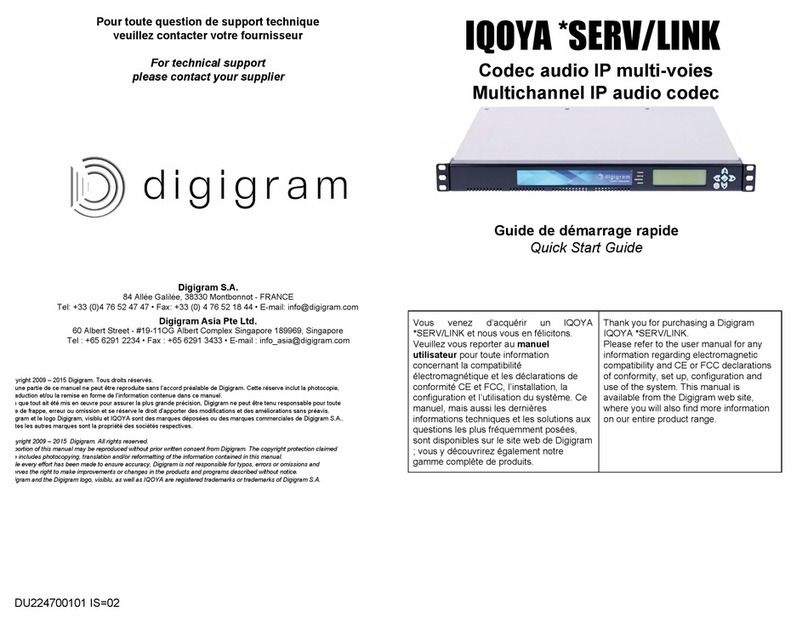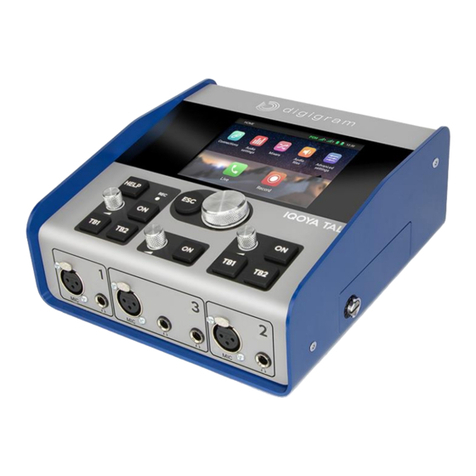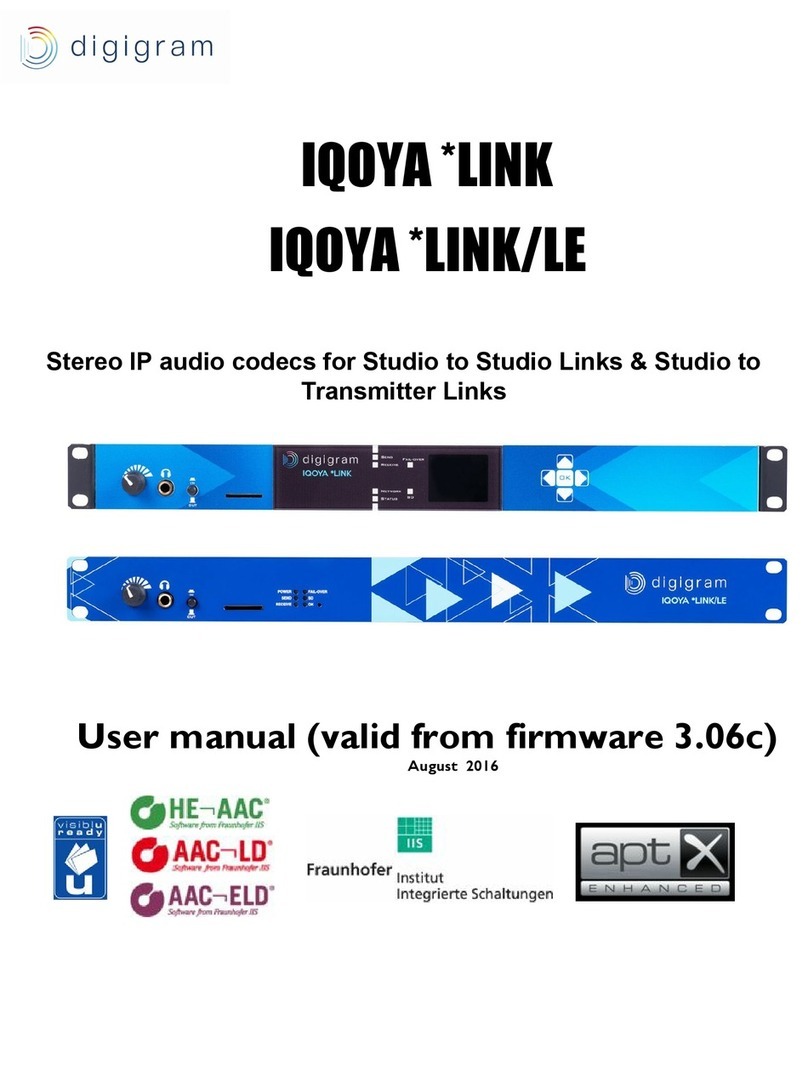
IQOYA X/LINK-MPX user manual
Important Safety Information: read carefully before using this equipment!
Follow these instructions and keep them in a safe place! Keep in mind that damages due to failure to
observe the instructions contained in this manual are not covered by warranty.
Instructions importantes de sécurité: lire soigneusement avant d’utiliser l’équipement!
Lisez et suivez ces instructions. Conservez-les pour consultation ultérieure! Les dommages dus au
non-respect des instructions contenues dans ce manuel ne sont pas couverts par la garantie.
Wichtige Sicherheitshinweise: vor Inbetriebnahme des Gerätes sorgfältig lesen!
Befolgen Sie die Anweisungen und bewahren Sie sie für spätere Fragen auf! Bei Schäden, die durch
Nichtbeachten dieser Bedienungsanleitung verursacht werden, erlischt der Garantieanspruch!
Throughout this manual, this pictogram is used to alert
the user to the risk of electric shock.
This pictogram is used to alert the user to important
operating or maintenance instructions
This pictogram is used to alert the user that the device has
multiple power sources.
WARNING - Risk of electric shock
Do Not Open the Cabinet
There are no user-serviceable components inside this
product. Opening the cabinet may present a shock
hazard, and any modification to the product will void
your warranty. If it is necessary to open the device for
maintenance or advanced configuration purposes, this
is to be done by qualified personnel only after
disconnecting the power cord and network cables!
WARNING - MULTIPLE POWER SOURCES
Power supply
The device is to be connected only to power supplies
as specified in this manual and marked on the
equipment.
This equipment must be earthed!
Do not block any of the ventilation openings!
Humidity
To reduce the risk of fire or shock, do not expose this
device to rain or moisture. Do not place objects filled
with liquid on this device.
Installation Location
To ensure proper operation and to avoid safety
hazards, the device must be installed in a 19“ rack
mount chassis. The electrical installation of the building
should dispose of easily accessible disconnecting
means in the immediate vicinity of the device.
If rack installation is not possible, place it on a firm and
level surface. The use of a supply lead with a power
plug respecting the legal standards in the country of
use is obligatory. The sockets outlets to which the
equipment is connected must be easily accessible.
Avoid installation in extremely hot or cold locations, or
in an area that is exposed to direct sunlight or heating
equipment. Avoid moist or humid locations.
Connection of this product to an IT power supply
system is only in Norway.
In Finland and Sweden the equipment is not intended to
be connected to a telecom network for the Ethernet
ports.
AVERTISSEMENT: risque de choc
électrique
Ne pas ouvrir l’appareil
L’ouverture du coffret peut produire un risque de choc
électrique, et toute modification du produit annule votre
garantie. S’il est nécessaire d’ouvrir l’appareil pour
l’entretien ou la configuration avancée, cela doit être fait
par du personnel qualifié, après avoir débranché le
cordon d’alimentation et les câbles réseaux !
AVERTISSEMENT - Sources d’alimentation
multiples
Alimentation
Il est primordial de connecter l’appareil à une
alimentation électrique telle que spécifiée dans ce
manuel d´utilisateur et sur le matériel même.
Cet équipement doit être raccordé à la terre !
N’obstruer aucune ouverture de ventilation !
Humidité
Afin de réduire les risques de feu ou de choc,
n’exposez pas cet appareil à la pluie ou l’humidité. Ne
placez pas d'objet contenant un liquide sur l’appareil.
Installation, mise en place
Afin d’assurer le fonctionnement correct et de minimiser
les risques potentiels liés à la sécurité, l’appareil doit
être installé dans un châssis 19 pouces. Si cela ne
vous est pas possible, placez-le sur une surface solide
et plane. Prévoir dans l’installation électrique du
bâtiment un dispositif de sectionnement aisément
accessible et à proximité immédiate de l’appareil.
L’utilisation d’un câble d’alimentation avec une fiche de
prise de courant respectant les normes en vigueur dans
le pays d’utilisation est obligatoire. De plus, les prises
de courant sur lesquelles sont branchées l'équipement
doivent être aisément accessible
Évitez une installation dans des endroits très chauds ou
très froids ainsi que dans des lieux exposés
directement au soleil. Évitez les lieux présentant un
excès d’humidité.
Le raccordement de ce produit à un régime
d’alimentation IT n’est possible qu’en Norvège.
WARNUNG - Stromschlaggefahr
Gerät nicht öffnen
Öffnen des Geräts kann eine Gefährdung durch
Stromschlag und Erlöschen der Garantie zur Folge
haben. Reparaturarbeiten und Änderungen der
Hardwarekonfiguration dürfen nur von qualifiziertem
Personal nach entfernen der Strom- und Netzwerkkabel
durchgeführt werden.
WARNUNG – MEHRERE STROMQUELLEN
Stromversorgung
Das Gerät darf nur mit der in dieser
Bedienungsanleitung und auf dem Gerät angegebenen
Stromversorgung betrieben werden.
Erdung ist zu gewährleisten!
Belüftungsschlitze nicht verdecken!
Wasser und Feuchtigkeit
Um Brand- oder Stromschlagrisiken zu vermeiden, darf
das Gerät nicht mit Feuchtigkeit in Berührung kommen.
Aufbau des Geräts
Um den einwandfreien Betrieb zu gewährleisten und
Sicherheitsrisiken zu vermeiden, sollte das Gerät in
einem 19-Zoll Baugruppenrahmen montiert werden. Die
elektrische Installation des Gebäudes sollte über einen
leicht zugänglichen Trennschalter in unmittelbarer Nähe
des Geräts verfügen Nur wenn die Installation im Rack
nicht möglich ist, stellen Sie das Gerät auf einen festen,
waagerechten Untergrund.
Die Verwendung eines Anschlußkabels und eines
Steckers, die die im Benutzungsland gültigen Normen
erfüllen, ist obligatorisch. Des weiteren muß die
Steckdose für einen eventuellen Problemfall leicht
zugänglich sein.
Meiden Sie Standorte in der Nähe von Wärme- oder
Feuchtigkeitsquellen sowie direkte Sonneneinstrahlung.
Anschluß dieses Produktes an eine spezielle
IT-Stromversorgung ist nur in Norwegen genehmigt.






























